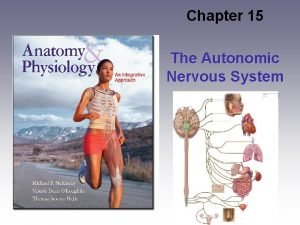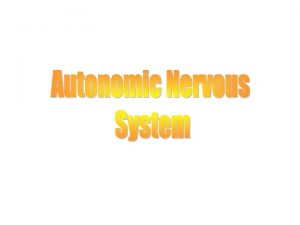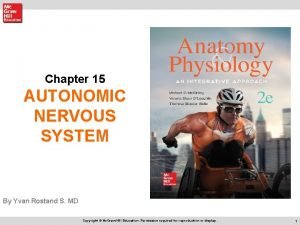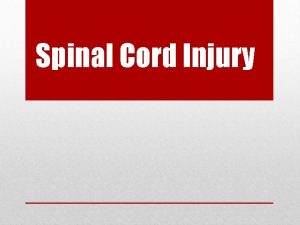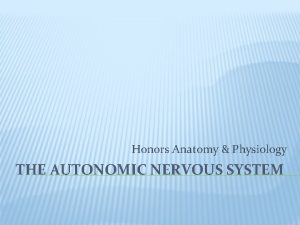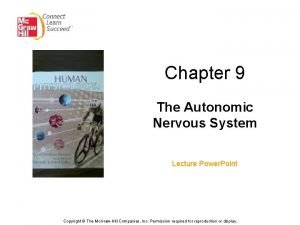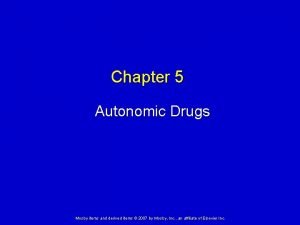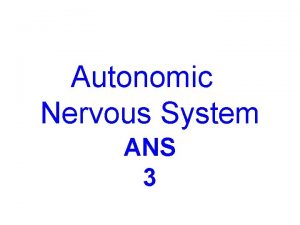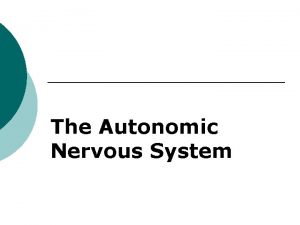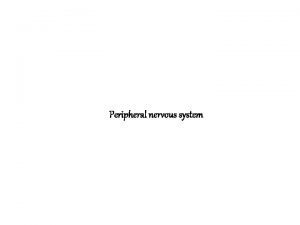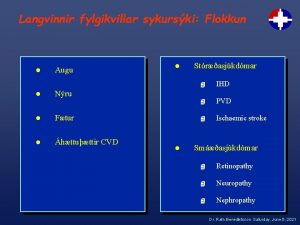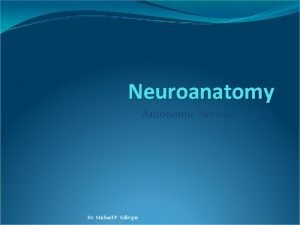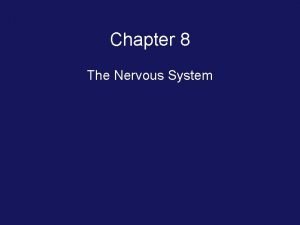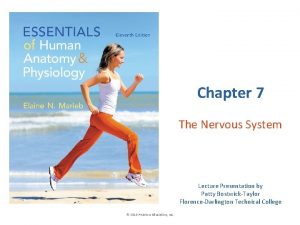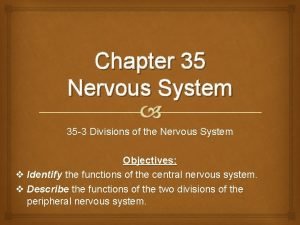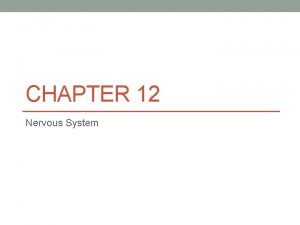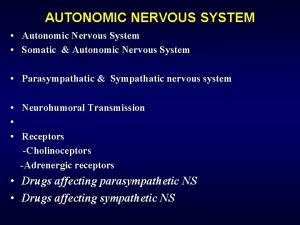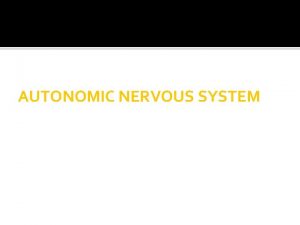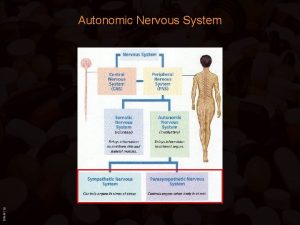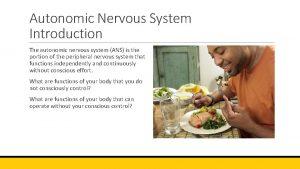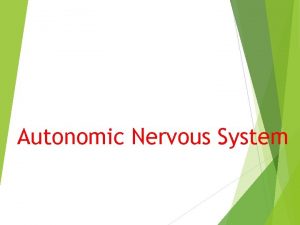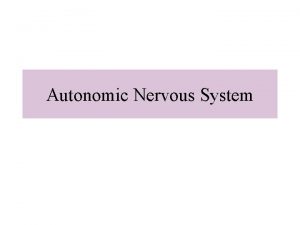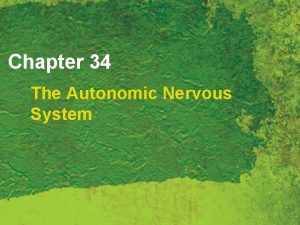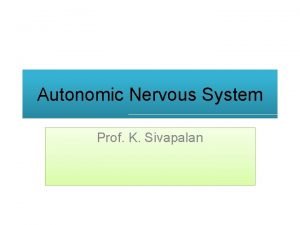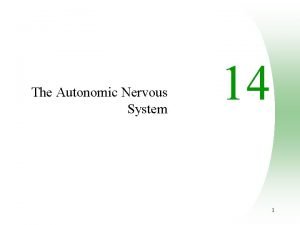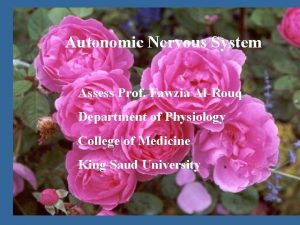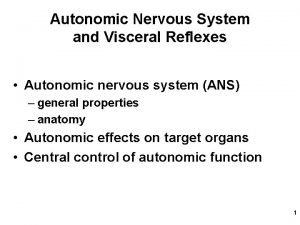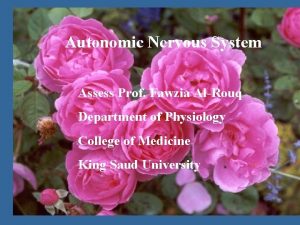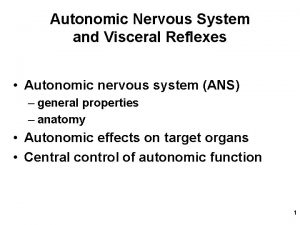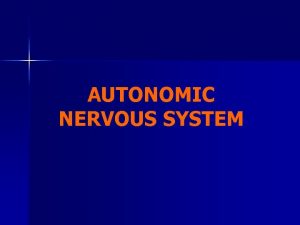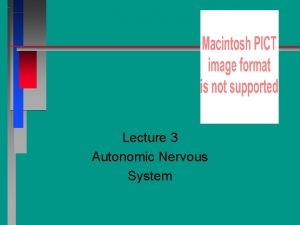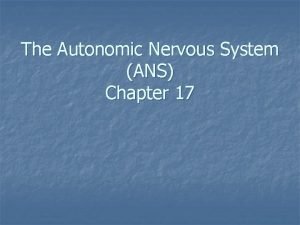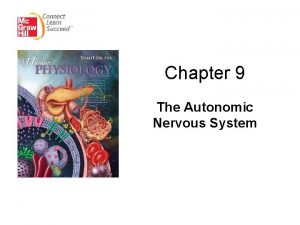Chapter 15 The Autonomic Nervous System Nervous System
























































- Slides: 56

Chapter 15 The Autonomic Nervous System

Nervous System: Autonomic Nervous System • Autonomic system – System of nerves mediating involuntary actions – Regulates body organ activity – Maintains normal internal functions – Divided into sympathetic and parasympathetic divisions – Allows for varied nervous system responses in times of stress and rest

Comparison of the Somatic and Autonomic Nervous Systems: Functional Organization • Somatic nervous system (SNS) – Includes processes perceived or controlled consciously – Somatic sensory portion • detects stimuli from special senses, skin, and proprioceptors • sends information to CNS – Somatic motor portion • transmits nerve signals from CNS to control skeletal muscles

Comparison of the Somatic and Autonomic Nervous Systems: Functional Organization • Autonomic nervous system (ANS) – Includes processes regulated below conscious level – Visceral sensory portion • detects stimuli from blood vessels and internal organs – Autonomic motor portion (visceral motor) • transmits nerve signals to cardiac muscle, smooth muscle, and glands – Functions to maintain homeostasis • constant internal environment – Regulates: • heart rate and blood pressure • respiratory rate, sweating, and digestion – Keeps these variables within optimal ranges

Comparison of the Somatic and Autonomic Nervous Systems: Motor Neurons • Lower motor neurons of SNS – Single lower motor neuron • • extends from CNS to skeletal muscle fibers cell body within brainstem or spinal cord exits CNS in cranial nerve or spinal nerve myelinated axons with large diameter – fastest conduction • always release acetylcholine (ACh) from synaptic knob

Comparison of the Somatic and Autonomic Nervous Systems: Motor Neurons • Lower motor neurons of ANS – Chain of two motor neurons • • • first neuron, the preganglionic neuron cell body within brainstem or spinal cord exits CNS in cranial nerve or spinal nerve projects to autonomic ganglion in PNS myelinated axons with small diameter – slower conduction • • releases ACh from synaptic knob second neuron, the postganglionic neuron cell body within autonomic ganglion exits ganglion to effector (cardiac muscle, smooth muscle, gland) • unmyelinated axons with even smaller diameter - slowest conduction • releases ACh or norepinephrine (NE) from synaptic knob

Comparison of the Somatic and Autonomic Nervous Systems: Motor Neurons postganglionic axon preganglionic axon ACh NE • Lower motor neurons of ANS (continued) – Chain of two motor neurons • allows for increasing communication and control • has neuronal convergence – multiple preganglionic neurons synapsing with single cell • has neuronal divergence – axons from one preganglionic cell synapsing with numerous cells

REVIEW

Divisions of the Autonomic Nervous Systems: Functional Differences • Motor component of ANS – Subdivided into parasympathetic and sympathetic divisions – Parasympathetic division • functions to maintain homeostasis at rest • energy conservation and replenishing stage • “rest-and-digest” division – Sympathetic division • • prepares the body for emergencies “fight-or-flight” division increased alertness and metabolic activity “three E’s”: emergency, exercise, or excitement

Divisions of the Autonomic Nervous Systems: Anatomic Differences • Parasympathetic • Sympathetic – Preganglionic neuron in lateral horns – Preganglionic neuron in of T 1 -L 2 brainstem or S 2 -S 4 spinal cord – Termed craniosacral division – Termed thoracolumbar division – Ganglionic neuron innervating muscles or glands – Preganglionic axons shorter – Preganglionic axons longer – Postganglionic axons shorter – Many preganglionic axons – Few preganglionic axons – Ganglia relatively close to spinal – Ganglia close to or within cord (in sympathetic trunk ganglia or effector prevertebral ganglia)

Figure 15. 3 Copyright © The Mc. Graw-Hill Companies, Inc. Permission required for reproduction or display. Autonomic Motor Nervous System Parasympathetic Division Origin: Preganglionic neurons located in brainstem nuclei and S 2–S 4 segments of spinal cord (craniosacral) Functions: • “Rest-and-digest” response • Brings body to homeostasis Sympathetic Division Origin: Preganglionic neurons located in lateral horns of T 1– L 2 segments of spinal cord (thoracolumbar) CN III (oculomotor) CN VII (facial) CN IX (glossopharyngeal) Sympathetic trunk CN X (vagus) T 1–L 2 segments of spinal cord S 2–S 4 segments of spinal cord Pelvic splanchnic nerves Functions: • Activated in emergency situations • “Fight-or-flight” response • Also involved with homeostasis

Divisions of the Autonomic Nervous Systems: Degree of Response • Parasympathetic activation – Local response – Due to long preganglionic neurons with limited branches

Divisions of the Autonomic Nervous Systems: Degree of Response • Sympathetic activation – Usually many structures activated simultaneously • termed mass activation • sometimes only single effector activated – Due to short preganglionic neurons with many branches – Especially important in response to stress • e. g. , multiple changes during exercising • increased heart rate, blood pressure, breathing rate, pupil dilation, etc.

Comparison of Neurotransmitters and Receptors of the Two Divisions: Overview of ANS Neurotransmitters • Neurotransmitters – Acetylcholine (ACh) and norepinephrine (NE) – Bind to specific receptors on postsynaptic cell – Cause stimulation or inhibition, depending on receptor

Comparison of Neurotransmitters and Receptors of the Two Divisions: Overview of ANS Neurotransmitters • Acetylcholine – Synthesized and released by cholinergic neurons • all sympathetic and parasympathetic preganglionic neurons • all parasympathetic ganglionic neurons • neurons innervating sweat glands and blood vessels of skeletal muscle – Bound by cholinergic receptors (two types)

Comparison of Neurotransmitters and Receptors of the Two Divisions: Overview of ANS Neurotransmitters • Norepinephrine – Bound by adrenergic receptors – Synthesized and released by adrenergic neurons • most other sympathetic ganglionic neurons • form network of swellings at target organ – termed varicosities – contain stored NE – NE released along length of axon

Comparison of Neurotransmitters and Receptors of the Two Divisions: Cholinergic Receptors • Nicotinic receptors – Category of cholinergic receptor – Sensitive to the drug nicotine – Found on all ganglionic neurons and adrenal medulla – When bound: • • open ion channels greater movement of Na+ into cell than K+ out of cell excitatory postsynaptic potential produced always produces a stimulatory response

Comparison of Neurotransmitters and Receptors of the Two Divisions: Cholinergic Receptors • Muscarinic receptors – Other category of cholinergic receptor – Responsive to muscarine, a mushroom toxin – Found in: • all target membranes in parasympathetic division • selected sympathetic cells • e. g. , sweat glands in skin, blood vessels in skeletal muscle – Different subtypes with different effects • either stimulated or inhibited by binding ACh • e. g. , binding of ACh in GI tract – results in stimulation and increased motility • binding on cardiac muscle – decreases heartbeat rate

Preganglionic axon Autonomic ganglion Ganglionic neuron cell body Postganglionic axon Figure 15. 10 Varicosities Smooth muscle cells Mitochondrion Synaptic vesicle containing NE Varicosity

Comparison of Neurotransmitters and Receptors of the Two Divisions: Adrenergic Receptors • Biogenic amines (monoamines) – Bind adrenergic receptors – Catecholamines, subcategory • have catechol ring structure in molecule • include dopamine, norepinephrine, and epinephrine – Two subtypes: • alpha (α) and beta (β) receptors

Comparison of Neurotransmitters and Receptors of the Two Divisions: Adrenergic Receptors • Alpha receptors – Typically stimulatory – α 1 receptors • • • located in most smooth muscle cells stimulate smooth muscle contraction found in most blood vessels (vasoconstriction) arrector pili muscle (contraction) uterus (contraction) ureters, internal urethral sphincter (closing) – α 2 receptors • • located in pancreas inhibit insulin secretion involved with contraction of GI tract sphincters facilitate blood clotting

Comparison of Neurotransmitters and Receptors of the Two Divisions: Adrenergic Receptors • Beta receptors – β 1 receptors • • • primarily stimulatory found in heart (increase heart rate and force) found in kidney (stimulate renin secretion) primarily inhibitory effects in smooth muscle of vessels to heart, liver, and skeletal muscle cause smooth muscle relaxation and vessel dilation lung (bronchodilation) uterine and GI tract smooth muscle (relaxation) detrusor muscle of bladder (relaxation)

Copyright © The Mc. Graw-Hill Companies, Inc. Permission required for reproduction or display. Parasympathetic Pathway Sympathetic Pathways Preganglionic axon releases ACh ACh Nicotinic receptors ACh NE Figure 15. 9 Ganglionic neuron cell body and dendrites always contain receptors for ACh. Postganglionic axon releases ACh or NE. Muscarinic receptors Target cells contain either ACh receptors (bind ACh) or NE receptors (bind NE). Target cell Muscarinic receptors Target cell (e. g. , sweat glands and blood vessels in skeletal muscle) Adrenergic receptors Target cell (e. g. , most other body structures)

Interactions Between the Parasympathetic and Sympathetic Divisions: Autonomic Tone • Most organs innervated by both divisions of ANS – Termed dual innervation – Stimulating continuously to varying degrees • referred to as autonomic tone • Autonomic tone – E. g. , diameter of most blood vessels in a partially constricted state • due to sympathetic tone – Decrease in stimulation below tone • causes vessel dilation – Increase above sympathetic tone • causes greater vessel constriction

Interactions Between the Parasympathetic and Sympathetic Divisions: Dual Innervation Antagonistic Effects – Parasympathetic and sympathetic effects usually antagonistic – E. g. , control of heart rate • parasympathetic stimulation slowing heart rate • sympathetic stimulation increasing heart rate • same cells with both muscarinic and adrenergic receptors – E. g. , control of muscular activity in GI tract • parasympathetic stimulation accelerating rate of contraction and motility • sympathetic stimulation decreasing motility • same cells with both types of receptors

Interactions Between the Parasympathetic and Sympathetic Divisions: Dual Innervation Antagonistic Effects (continued) – E. g. , control of pupil diameter in the eye • parasympathetic stimulation of circular muscle layer of iris – causes pupil constriction • sympathetic stimulation of radial muscle layer of iris – causes pupil dilation • different effectors innervated

Interactions Between the Parasympathetic and Sympathetic Divisions: Dual Innervation Cooperative Effects – When both parasympathetic and sympathetic produce single result – E. g. , male sexual function • penis erect due to parasympathetic innervation • ejaculation due to sympathetic innervation

Parasympathetic and Sympathetic Interactions: Systems Controlled Only by Sympathetic Division • Opposing effects without dual innervation – E. g. , blood vessels innervated by sympathetic axons only • cause increased smooth muscle contraction and blood pressure • vasodilation achieved by decreasing stimulation below autonomic tone – E. g. , sweat glands in the trunk and arrector pili muscles in the skin • cause sweating and “goosebumps” – E. g. , neurosecretory cells of adrenal medulla • release epinephrine and norepinephrine, prolonging fight-or-flight effects

Control and Integration of Autonomic System Function: CNS Control of the ANS • Involvement of CNS – ANS is a regulated nervous system, not independent – Influenced by four CNS regions: • cerebrum, hypothalamus, brainstem, and spinal cord – Cerebrum • ANS affected by conscious activities here – Hypothalamus • • • integration and command center for autonomic functions communicates with association areas of cortex affected by sensory processing in thalamus impacted by emotional states in limbic system also communicates with brainstem, cerebellum, and spinal cord central structure involved in drives that act through ANS

Control and Integration of Autonomic System Function: CNS Control of the ANS • Involvement of CNS (continued) – Brainstem nuclei • mediate major ANS reflexes • control changes in blood pressure, blood vessel diameter, and digestion • control changes in heart rate, pupil size, and eye lens shape for focusing – Spinal cord • some autonomic responses controlled at level of spinal cord • e. g. , defecation and urination (in children) • may be inhibited by higher centers

Figure 15. 14 Cerebrum Conscious activities in the cerebrum affect hypothalamus control of the ANS Hypothalamus Integration and command center for autonomic functions; involved in emotions Brainstem Contains major ANS reflex centers Spinal cord Contains ANS reflex centers for defecation and urination 31

THE END 32


34

Comparison of the Somatic and Autonomic Nervous Systems: Functional Organization What criterion is used to organize the nervous system into the SNS and the ANS? The somatic nervous system involves processes that are perceived or controlled consciously. The autonomic nervous system includes processes regulated below the conscious level.

Comparison of the Somatic and Autonomic Nervous Systems: Motor Neurons What are the anatomic features that distinguish the motor neurons in the SNS and the ANS? The somatic nervous system has a single lower motor neuron extending from the CNS. It has large, myelinated axons and always releases ACh. The autonomic nervous system has a chain of two lower motor neurons extending from the CNS. The first neuron synapses in a ganglion, has small myelinated axons, and always releases ACh. The second has small unmyelinated axons and releases ACh or NE.

Divisions of the Autonomic Nervous Systems: Functional Differences The parasympathetic division is responsible for what main functions? Maintains homeostasis at rest, conserves energy, and replenishes nutrient stores

Divisions of the Autonomic Nervous Systems: Anatomic Differences Compare the parasympathetic and sympathetic divisions, in terms of types of axons and locations of ganglia. The parasympathetic division has short axons with relatively few branches and ganglia located close to or within the wall of the organ. The sympathetic division has long axons with many branches and ganglia located in the sympathetic trunk or prevertebral ganglia.

Parasympathetic Division: Cranial Components Which four cranial nerves have a parasympathetic component? What organs are innervated by each? The oculomotor nerve innervates the ciliary and constrictor muscles of the eye. The facial nerve innervates the lacrimal, submandibular, and sublingual glands. The glossopharnygeal nerve innervates the parotid salivary gland. The vagus nerve innervates the thoracic organs, most of the abdominal organs, and the gonads.

Parasympathetic Division: Pelvic Splanchnic Nerves What organs are innervated by the pelvic splanchnic nerves? Most abdominal organs; pelvic organs

Sympathetic Division: Organization and Anatomy What are the structural and functional differences between the white and gray rami communicantes? The white rami communicantes carry preganglionic sympathetic axons from the T 1 -L 2 spinal nerves to the sympathetic trunk. They are myelinated. The gray rami communicantes carry postganglionic sympathetic axons from the sympathetic trunk to the spinal nerve. They are unmyelinated.

Sympathetic Division: Organization and Anatomy Where are the splanchnic nerves in the sympathetic division located, and what is their function? The splanchnic nerves run anteriorly from the sympathetic trunk to most of the viscera. They extend from axons from T 5 -L 2. They are composed of preganglionic sympathetic axons that did not synapse in a sympathetic trunk ganglion.

Sympathetic Division: Sympathetic Pathways How do the pathways of the spinal nerve and splanchnic nerve sympathetic pathways differ? In the spinal nerve pathway, a preganglionic neuron synapses with a neuron in the sympathetic trunk. The post ganglionic axon travels through a gray ramus at the same level. In the splanchnic nerve pathway, preganglionic axons pass through the sympathetic trunk without synapsing and extend to the prevertebral ganglia, synapsing there.

Comparison of Neurotransmitters and Receptors of the Two Divisions: Overview of ANS Neurotransmitters Which ANS neurons are cholinergic? Which are adrenergic? Cholinergic: all sympathetic and parasympathetic preganglionic neurons, all parasympathetic ganglionic neurons, sweat glands and blood vessels in skeletal muscle tissue Adrenergic: most other sympathetic ganglionic neurons

Comparison of Neurotransmitters and Receptors of the Two Divisions: Cholinergic Receptors Where are nicotinic and muscarinic receptors each located? Nicotinic receptors are located on cell bodies of all ganglionic neurons and on the adrenal medulla. Muscarinic receptors are located in the target membranes of the parasympathetic division, and in a few sympathetic target cells (sweat glands, blood vessels in skeletal muscles).

Comparison of Neurotransmitters and Receptors of the Two Divisions: Cholinergic Receptors When a neurotransmitter binds to a nicotinic effector, is the effect stimulatory or inhibitory? Stimulatory (excitatory)

Comparison of Neurotransmitters and Receptors of the Two Divisions: Adrenergic Receptors Stimulation of β 1 receptors causes what effects? Increased rate and force of heart contraction; stimulation of renin in the kidney

Interactions Between the Parasympathetic and Sympathetic Divisions: Dual Innervation What are the antagonistic effects of the sympathetic and parasympathetic divisions on pupil size? Parasympathetic stimulation causes pupil constriction, due to stimulation of the circular muscle layer in the iris. Sympathetic stimulation causes pupil dilation, due to stimulation of the radial muscle layer in the iris.

Parasympathetic and Sympathetic Interactions: Systems Controlled Only by Sympathetic Division What are the body structures innervated by the sympathetic division only? Many blood vessels, sweat glands in the trunk, arrector pili in the skin, adrenal medulla

Control and Integration of Autonomic System Function: Autonomic Plexuses What basic structures form an autonomic plexus? Sympathetic postganglionic axons, parasympathetic preganglionic axons, some visceral sensory axons

Control and Integration of Autonomic System Function: Autonomic Reflexes How does the cardiovascular reflex affect blood pressure? When blood pressure elevates, stretch receptors in large blood vessels are stimulated. They signal the cardiac center in the medulla. These nerve signals inhibit sympathetic output and activate parasympathetic output to the heart. This slows the heart rate and decreases the volume of blood ejected, decreasing blood pressure.

Control and Integration of Autonomic System Function: CNS Control of the ANS What CNS structure is the integration and command center for autonomic function? The hypothalamus

Sympathetic Division: Organization and Anatomy Clinical View: Horner Syndrome – Injury of cervical sympathetic trunk or T 1 trunk ganglion – Symptoms on same side of head – Impairment of sympathetic signaling – Ptosis • drooping of superior eyelid • due to paralysis of superior tarsal muscle – Miosis • constricted pupil • due to paralysis of pupil dilator muscle

Sympathetic Division: Organization and Anatomy Clinical View: Horner Syndrome (continued) – Anhydrosis • lack of sweating • sweat glands not receiving sympathetic innervation – Facial flushing • due to vasodilation due to lack of sympathetic innervation

Control and Integration of Autonomic System Function: Autonomic Reflexes Clinical View: Autonomic Dysreflexia – Causes blood pressure to rise profoundly – Stimulates a sympathetic reflex • causes systemic vasoconstriction • marked increase in blood pressure – Caused by hyperactivity of ANS after a spinal cord injury – Initial response to injury is spinal shock, with loss of autonomic reflexes – Abnormal response to lack of innervation, denervation hypersensitivity • e. g. , involuntary relaxation of internal urethral sphincter • due to spinal cord reflex

Parasympathetic and Sympathetic Interactions: Systems Controlled Only by Sympathetic Division Clinical View: Raynaud Syndrome – Sudden constriction of small arteries of digits – Results in loss of normal hue of distal skin – Accompanied by pain – Triggered by cold or emotional stress – Due to exaggerated local sympathetic response – More common in women
 Parasympathetic
Parasympathetic Somatic vs autonomic nervous system
Somatic vs autonomic nervous system Autonomic nervous system consists of
Autonomic nervous system consists of Ans
Ans Autonomic
Autonomic Autonomic nervous system
Autonomic nervous system The autonomic nervous system controls
The autonomic nervous system controls Adrenal gland sympathetic nervous system
Adrenal gland sympathetic nervous system Autonomic dysreflexia
Autonomic dysreflexia Divisions of the nervous system
Divisions of the nervous system Fundamentals of the nervous system and nervous tissue
Fundamentals of the nervous system and nervous tissue Fundamentals of the nervous system and nervous tissue
Fundamentals of the nervous system and nervous tissue Neuronal pools are collections of
Neuronal pools are collections of Autonomic nerveous system
Autonomic nerveous system Anal wink reflex
Anal wink reflex Autonomic reflex arc
Autonomic reflex arc Terminal ganglia
Terminal ganglia Autonomic network management
Autonomic network management An architectural blueprint for autonomic computing
An architectural blueprint for autonomic computing Mosby items and derived items
Mosby items and derived items Autonomic drugs
Autonomic drugs The vision of autonomic computing
The vision of autonomic computing Autonomic reflexes
Autonomic reflexes Autonomic state
Autonomic state Autonomic computing ibm
Autonomic computing ibm Diabetic autonomic neuropathy
Diabetic autonomic neuropathy Autonomic bladder
Autonomic bladder Autonomic decision making
Autonomic decision making Autonomic motor neurons regulate visceral activities by
Autonomic motor neurons regulate visceral activities by Bipolar neuron function
Bipolar neuron function Chapter 15 nervous system diseases and disorders
Chapter 15 nervous system diseases and disorders Chapter 8 the nervous system
Chapter 8 the nervous system Chapter 7 the nervous system figure 7-2
Chapter 7 the nervous system figure 7-2 Chapter 35 nervous system
Chapter 35 nervous system Chapter 14 the skeletal muscular and nervous systems
Chapter 14 the skeletal muscular and nervous systems Chapter 12 nervous system
Chapter 12 nervous system Nervous system and digestive system
Nervous system and digestive system Endocrine system and nervous system
Endocrine system and nervous system Mechanism of action of hormones
Mechanism of action of hormones Adh function
Adh function Hình ảnh bộ gõ cơ thể búng tay
Hình ảnh bộ gõ cơ thể búng tay Ng-html
Ng-html Bổ thể
Bổ thể Tỉ lệ cơ thể trẻ em
Tỉ lệ cơ thể trẻ em Gấu đi như thế nào
Gấu đi như thế nào Tư thế worm breton
Tư thế worm breton Chúa yêu trần thế
Chúa yêu trần thế Các môn thể thao bắt đầu bằng tiếng bóng
Các môn thể thao bắt đầu bằng tiếng bóng Thế nào là hệ số cao nhất
Thế nào là hệ số cao nhất Các châu lục và đại dương trên thế giới
Các châu lục và đại dương trên thế giới Công thức tính độ biến thiên đông lượng
Công thức tính độ biến thiên đông lượng Trời xanh đây là của chúng ta thể thơ
Trời xanh đây là của chúng ta thể thơ Mật thư tọa độ 5x5
Mật thư tọa độ 5x5 Làm thế nào để 102-1=99
Làm thế nào để 102-1=99 độ dài liên kết
độ dài liên kết Các châu lục và đại dương trên thế giới
Các châu lục và đại dương trên thế giới Thơ thất ngôn tứ tuyệt đường luật
Thơ thất ngôn tứ tuyệt đường luật





